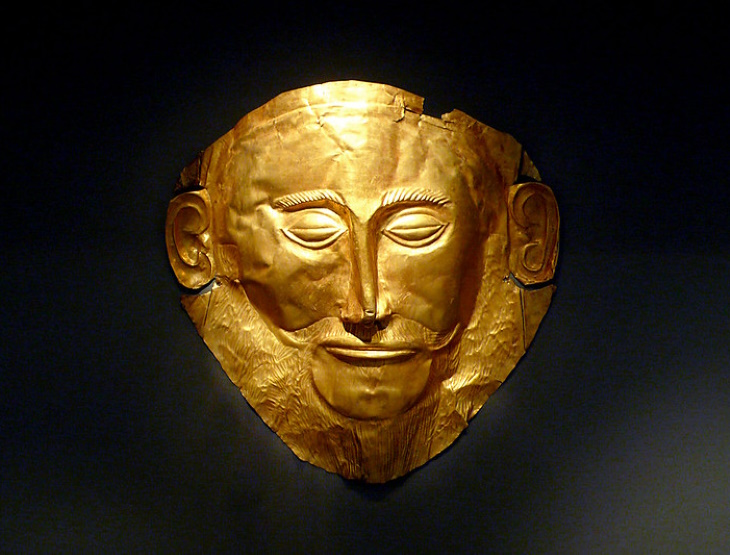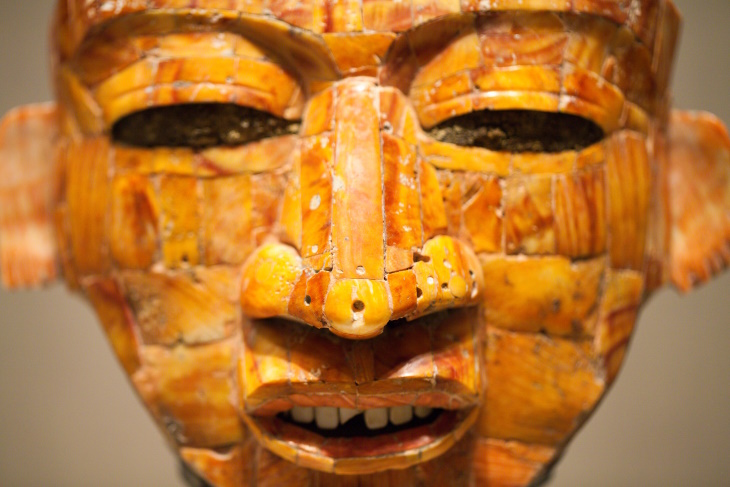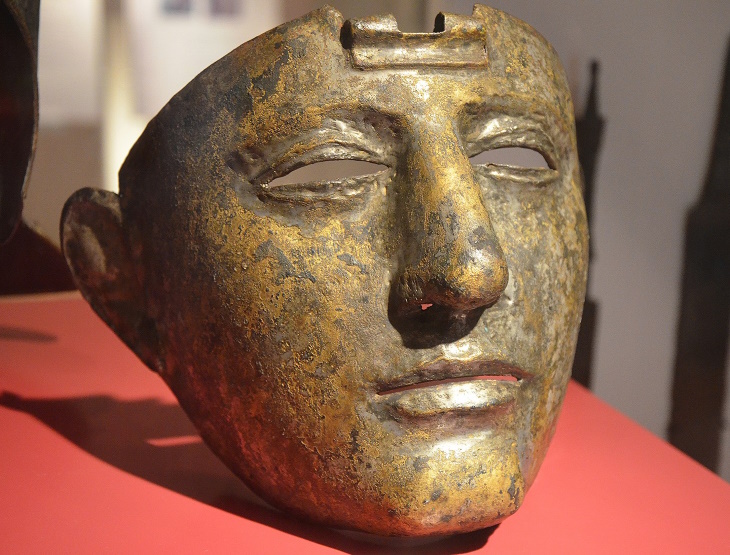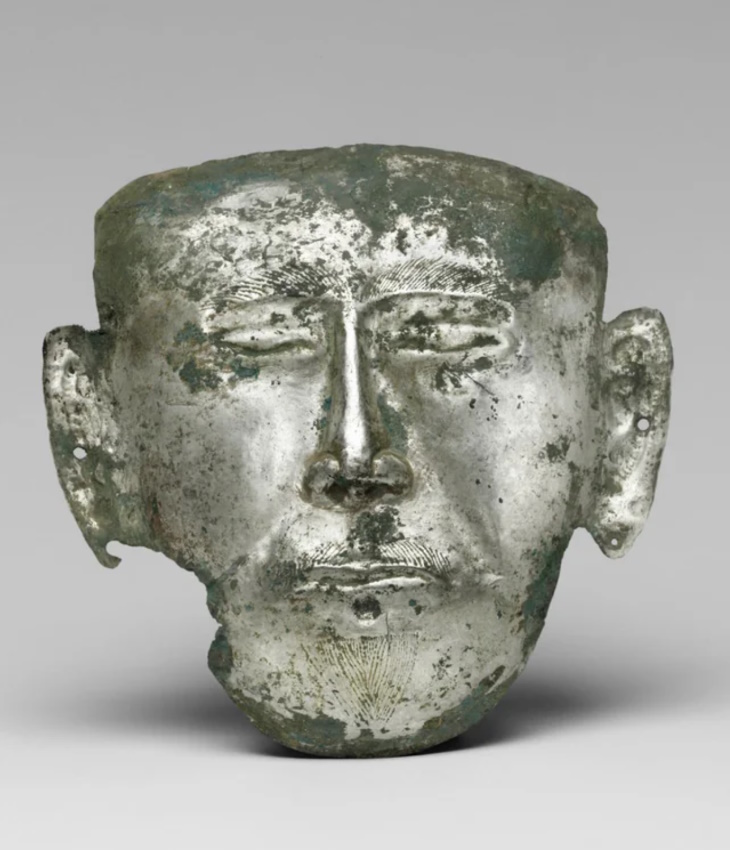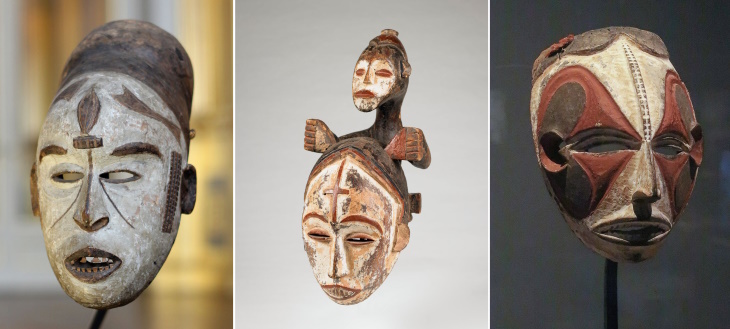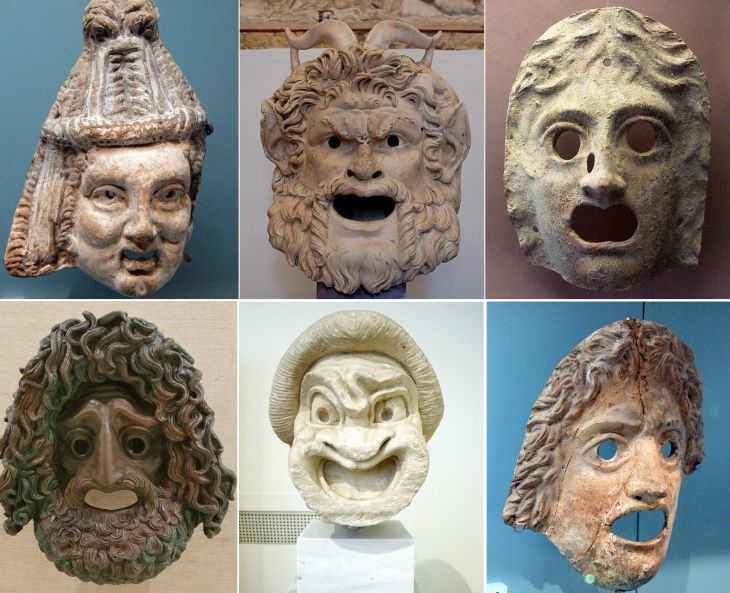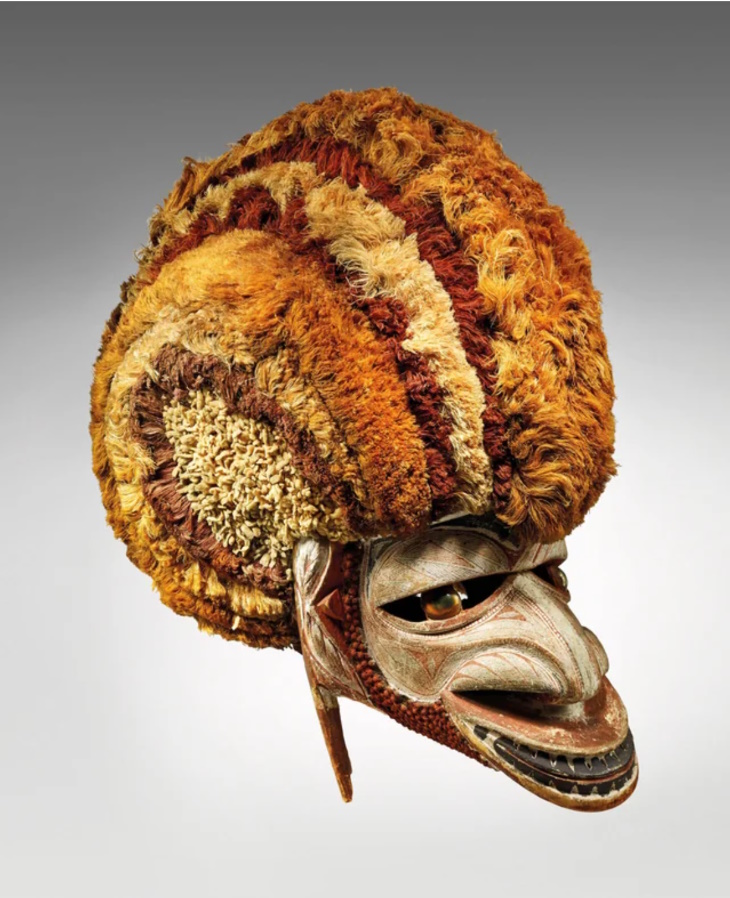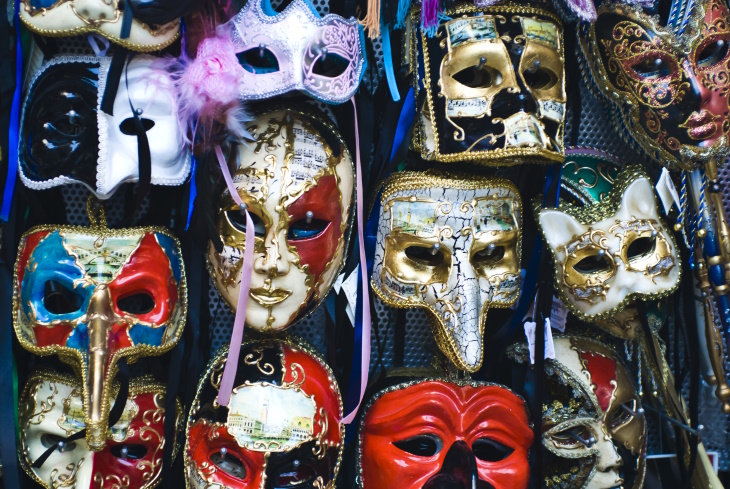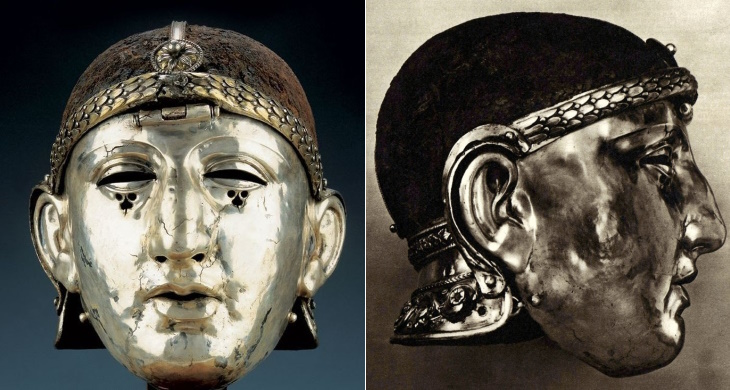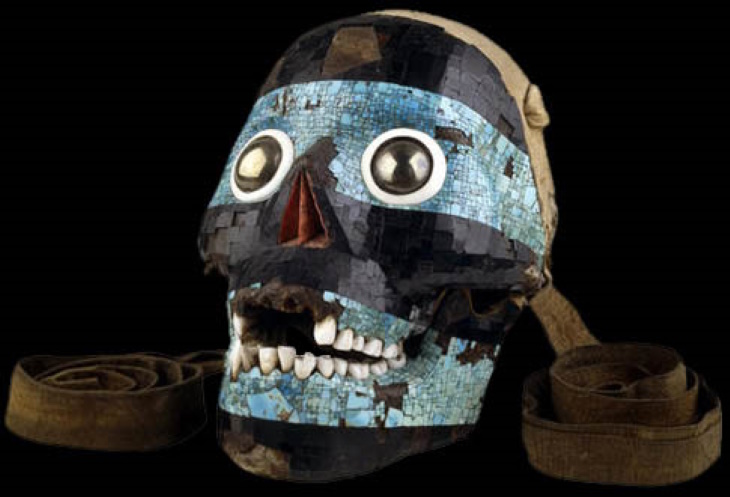Neolithic Spirit Masks
Spirit Masks from Nahal Hemar, Israel (7,000 BC) Image: Reddit
At first glance, these simple stone masks may appear a bit underwhelming if not eerie. They look nothing like other famous masks, such as the intricate golden mask of Tutankhamun or the famous Venetian Carnival masks. That’s because their value lies in their age, and not in their appearance. What you’re looking at are the oldest masks in the world, and they were discovered not so long ago in the Judean Desert.
Carbon dating revealed that these masks are nine thousand years old! This would place them at a point in time when organized settlements just appeared, and humans started organizing in early farming communities. Researchers believe that these limestone masks, which were likely painted, could depict specific individuals, as their shapes appear to be unique. Alternatively, they could represent ancestral spirits or deities that were part of their early Stone Age belief system.
Egyptian Funerary Masks
King Tutankhamun’s golden mask is arguably the most iconic and easily recognizable mask in the world. The precious artifact is a prime example of the long Ancient Egyptian tradition of funerary masks placed on the mummified body before burial.
Made of gold decorated with semi-precious stones, Tutankhamun’s mask features a striped headdress with images of the protective deities Wadjet and Nekhbet, a decorative collar, bold eye makeup, and a ceremonial beard. The features of the pharaoh are idealized and nearly god-like to show that it represents a ruler.
As we will see throughout this article, the practice of creating funerary masks has been widespread across many civilizations and continents. However, the Ancient Egyptians brought it to the level of high artistry. It all stems from the belief that preserving the face is paramount for maintaining the identity of the wearer and helping them live on in the afterlife.
Mycenean Death Mask of Agamemnon
Mycenae, Greece (1550-1500 BC) Image: Flickr
The cultural origins of this world-famous funerary mask are shrouded in mystery, as scientists know very little about the early Greek tribes who created it. However, it’s nearly certain that this death mask of a bearded man certainly did not belong to the famous king Agamemnon of Homer’s Iliad. After all, the mask predates the mythical ruler by four centuries, a time before the Ancient Greeks as seen in popular culture.
Still, we must give the German archaeologist Heinrich Schliemann, who discovered the mask in 1876, credit for claiming it belonged to Agamemnon. It most certainly contributed to the artifact’s popularity and with it the popularity of the Mycenean tradition of burying elites clad in golden masks, armor, and jewelry.
Noh Masks

A Variety of Japanese Noh Masks Images from left to right, top to bottom: 1, 2, 4, 5
Apart from religion and the military, masks often play an important role in theater. Wearing a mask makes the actor transform into a character almost instantly. One of the most unique theatrical traditions that utilize masks can be found in Japan. Called Noh, this classical Japanese theater found its roots in the spirit and animal masks of early pagan traditions. However, the formal theater itself was established during the Muromachi period (1392-1573).
At this time, masks have transformed from a religious tradition to an artistic one, and with that, more and more human characters have emerged in plays. The oldest plays featured about 60 masks, but today, that list has grown to over 200. Humans, animals, spirits, and demons are all represented. Probably the most striking and famous of them are the horned Kishin (demon) masks.
Traditionally, noh masks are carved out of wood and painted by Noh actors themselves or mask makers. Like many other artistic traditions, noh was a hereditary art form with a centuries-long lineage. Even today, there are a number of mask makers and noh performers.
Teotihuacan Ritual Masks
Shell Mosaic Ritual Mask, Teotihuacan, Mexico (AD 300-600) Image: Flickr
Long before the Aztecs of the 14-15th century, modern-day Mexico was inhabited by the Teotihuacan civilization. The ruins of this city-state that existed between AD 200-400 can be seen near Mexico City. This was a powerful Mesoamerican culture that built the second-largest city in the world (Beijing was the largest at the time).
A characteristic feature of Teotihuacan culture and art is the ritual mask. These highly decorative and stylized masks would not be worn; instead, they were attached to wooden frames decorated with clothing, jewelry, and feathers, and displayed in homes and at temples.
Masks like this one had an important ritual function. It was made by modifying an old stone mask and decorating it with mosaic tiles made from shells. Rare Spondylus shells were used, suggesting that the mask was a cherished possession. The current understanding of these artifacts' ritual significance supports this. The Teotihuacan people believed that these masks embodied their ancestors. Caring for the masks was crucial, as ancestor spirits would then help the living prosper.
Roman Calvary Masks
Cavalry Face-Mask Helmet, Kops Plateau, the Netherlands (c. AD 10-40) Image: Wikimedia Commons
The military mask is another type of headwear historians have observed across several civilizations. Ancient Roman soldiers, particularly cavalry, would wear helmets that extended to the entire face and neck. Such a mask offered extra protection and gave a psychological advantage in battle. Without seeing the soldier’s facial expression, the enemy would not be able to predict his actions as well. Masks would also be worn on parades as a visual display of the Roman military’s strength.
The military mask you see right above is made of iron and brass, and it was originally attached to a helmet. The mask was found in the Netherlands on the site of the Roman defeat during the Battle of the Teutoburg Forest in September AD 9. It’s one of the oldest Roman military masks ever found, and a prime example of the fine craftsmanship achieved by the Ancient Romans.
Khitan Funerary Masks
Silver Khitan Mask (c. AD 900-1000) Image: Reddit
Funerary masks appeared early on in Chinese history. Among the first were jade masks from the Eastern Zhou period (770-256 BC). The nomadic Khitan people, who inhabited north China and Mongolia in the Liao dynasty (907-1125), shifted to metal masks. They buried the dead by wrapping the body in metal mesh and placing personalized metal masks over the face of the deceased. They believed that a metal suit and mask would protect the body from decay. One’s ranking in the tribe influenced what metals were used; the elites were laid to rest wearing silver and gold masks.
The mask below is made of silver, and it depicts a male’s face with a relaxed and serene facial expression. Notice the pierced ears; both Khitan men and women customarily wore earrings.
Igbo Masks
Wooden Igbo Masks, Nigeria Images from left to right: 1, 2, 3
In some cases, it's impossible to determine a tradition's exact or even rough date. This is the case when materials that degrade over time, such as wood or straw, are utilized. Luckily, some of these traditions are still alive today, and their intricacy and importance are sure signs of their endurance over centuries or even millennia. West Africa - a vast territory from Nigeria to the shores of the Atlantic - is especially famous for its rich and complex masking traditions. Most masks are made of painted wood decorated with beads, shells, fabric, and raffia and worn with a costume.
The Igbo people of Nigeria are known for conducting annual masked performances that combine rituals, moral lessons, and entertainment in one. Maskers, or mmanwu, are a secretive male society that creates masks and costumes. During the performance, mmanwu personalize various types of characters ranging from supernatural entities to famous ancestors and even animals. These masked ceremonial dances usually occur during the dry season to ensure a fruitful harvest and just to entertain. Each mask is one-of-a-kind and handmade by a master.
Greek Theater Masks
Greek Theater Masks Images from left to right, top to bottom: 1, 2, 3, 4, 5, 6
Ancient Greeks were another civilization famous for their theater masks. After all, these antique cultures were the ones to invent the basics of theater in the western world. And masks were an integral part of the whole story, as the theaters of the time were large and open-air. Hence, an actor would have to wear a mask to really exaggerate the facial expression enough to be seen and understood by spectators in the last rows.
Theater masks had various expressions and depicted both male and female characters, as well as gods, monsters, and other minor deities like satyrs. Chances are, you’ve seen a Greek theater mask in a museum. Well, kind of... Technically, all museum specimens are not masks worn by actors but terracotta replicas held as decorations in temples.
Tibetan Cham Masks
A Cham Dance Performance
Traditional Tibetan masks are called ba in Tibetan, and they are precious relics of a distant time in Tibetan history before Buddhism arrived and dominated the region - even though the physical masks themselves are made of disposable materials. These colorful masks depict animals and gods, and they are primarily worn in Tibetan religious dances and folk performances.
As early as the 7th century AD, the Tubo Kingdom period, there are mentions of masked folk dances that mimic animals. At this time, a religion called Bon was dominant in Tibet. Interestingly, mask-wearing ritual dances persisted after the spread of Buddhism. In fact, the Cham dance is still performed by Tibetan monks today; they put on masks and perform as ancient deities, demons, and famous figures. Cham masks are an essential element, even though they're notoriously uncomfortable to wear, as they are quite heavy and have no openings for the eyes and mouth.
Tatanua Masks
Melanesian Culture, Papua New Guinea (c. 19th century) Image: Reddit
The Malangan ceremonies of Papua New Guinea are an elaborate mortuary tradition that honors the dead and celebrates the living. It involves feasts, dances, and other rituals that take many months or even years to prepare. Tatanua masks are an important feature of dance performances.
Carved of wood and decorated with paint, shells, and fiber, Tatanua masks are reminiscent of human and animal figures. The masks are meant to represent the spirit of the deceased. Sometimes, the masks are destroyed, but at other times, they are saved for sentimental purposes. However, these masks are not funerary, as it is the living Tatanua dancers, and not their deceased relatives, that wear them.
Venetian Carnival Masks
The image of an opulent masquerade ball is one we all can conjure up in our minds in an instant, but have you ever wondered where it came from? This tradition of holding costumed dances spread across the noble estates of western Europe during the late Renaissance (16th century), but its origins invariably take us to the Venetian Carnival.
In the Middle Ages, Venice had a rigid and restrictive class system, where common folk was not permitted to wear expensive garments and visit elite places. One theory is that masks cropped up to bypass such laws. By the 13th century, masks had become so widespread that their use was restricted to the Carnival season. However, Venetians could still spend a large portion of the year in disguise.
Masks were produced by specialized artists called mascherari, who first used leather or porcelain as a base, and later moved to glass and papier-mache. Several symbolic styles of masks, like the bauta (Venetian man mask) or gnaga (cat mask) emerged as a result.
The Emesa Helmet
Aramaean Culture, Syria (c. AD 50) Image: Imgur
Like the masks of the Roman cavalry, some Aramaean warriors and noblemen likely wore metal helmets that covered their entire faces too. The intricately-crafted iron helmet you can see above was found at the royal necropolis near modern-day Homs, Syria. Two millennia ago, the area belonged to the wealthy kingdom of Emesa and played an important role in the trade routes between Europe and the Near East.
The metal helmet most likely belonged to a prominent warrior, nobleman, or even the king. The shape of the mask was personalized to the owner’s facial features. The base is made of iron and coated in silver; it bears intricate detailing, including teardrop-shaped holes under the eye openings that served the purpose of expanding the wearer’s field of vision. Historians believe that the mask was worn in combat and possibly for ceremonial purposes.
Aztec Skull Masks
Tezcatlipoca Mask, Mixtec Culture, Mexico (c. 1485) Image: Reddit
Some historical masks are a gruesome reminder of civilizations that practiced ritual sacrifice. The Aztec skull masks found at the Great Temple of Tenochtitlan, the capital of the Aztec Empire, are among them. Dedicated to the Aztec war and sun god Huitzilopochtli, the temple held a terrifying surprise for archaeologists. Thousands of people were sacrificed there, and some of the skulls were halved and fashioned into wearable masks.
Following a thorough investigation, scientists were able to conclude that all of the skulls belonged to able-bodied males aged 30-45 from various corners of the Aztec empire, likely slain warriors or even rival rulers.
Among the handful of skull masks that have survived to this day, the blue mask you see above is the most famous. It is said to depict the god Tezcatlipoca, who was also the deity of warriors, sorcerers, and rulers. The skull mask was lined with leather and fashioned with leather straps. At the front, the mask was decorated with turquoise, shell, and lignite sourced from various corners of the empire.
Japanese Menpo
Japanese Samurai Armor Featuring a Menpo (c. 1550) Image: Wikimedia Commons
Also known as men-yoroi, menpo refers to the variety of facial armour worn by Japanese samurai in feudal Japan (AD 1185-1603). Some menpo only covered the chin or the lower part of the face, but a type of facial armor that covered the entire face, called somen, also existed. Even though the first images and mentions of men-yoroi date back to the 10-11th centuries, somen were likely introduced late around the 15th century.
Together with the helmet (kabuto), it fully protected the head. Somen was made of lacquered iron and leather, and they were quite expensive to produce. The military mask showed a fearsome facial expression to scare the enemy.



